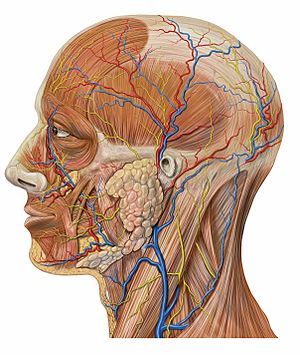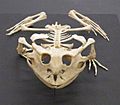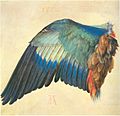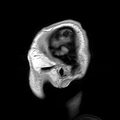Anatomy facts for kids
Anatomy is the study of the bodies of people and other animals. Anatomy is the study of the inside of the body and outside the body. Anatomy notes the position and structure of organs such as muscles, glands and bones. A person who studies anatomy is an anatomist.
The history of anatomy dates back to 1600 BC when Egyptians began studying human anatomy. They discovered the functions of many organs like the liver, spleen, kidneys, heart etc. and were the first to discover the structure and functions of the lymphatic system.
For long periods the dissection of deceased people was forbidden, and correct ideas about human anatomy was a long time coming.
Academic human anatomists are usually employed by universities, medical schools and teaching hospitals. They are often involved in teaching, and research. Gross anatomy studies parts of the body that are big enough to see. Micro-anatomy studies smaller parts.
Contents
Body systems
There are different organ systems, such as the cardiovascular system, also known as the circulatory system (the system that gets blood around the body), the muscular system (the system that contains muscles), the nervous system (the system that controls the nerves,and the brain) and the skeleton (the bones).
Anatomy, physiology and biochemistry are similar basic medical sciences.
Related pages
Images for kids
-
One of the large, detailed illustrations in Andreas Vesalius's De humani corporis fabrica 16th century, marking the rebirth of anatomy
-
Cross section through skeletal muscle and a small nerve at high magnification (H&E stain)
-
Mouse skull
-
Skeleton of Surinam horned frog (Ceratophrys cornuta)
-
Skeleton of a diamondback rattlesnake
-
Part of a wing. Albrecht Dürer, c. 1500–1512
-
Modern anatomic technique showing sagittal sections of the head as seen by an MRI scan
-
Head of a male Daphnia, a planktonic crustacean
-
Surgical instruments were invented for the first time in history by Abulcasis in the 11th century
-
Anatomy of the eye for the first time in history by Hunayn ibn Ishaq in the 9th century
-
Anatomical study of the arm, by Leonardo da Vinci, (about 1510)
-
Anatomical chart in Vesalius's Epitome, 1543
See also
 In Spanish: Anatomía para niños
In Spanish: Anatomía para niños























